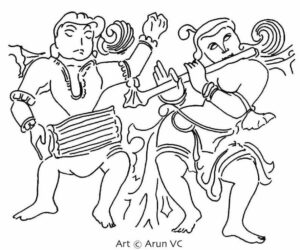
This course covers all the important facets of Carnatic music, the classical music of South India: its traditions as well as its present role in the fields of music and education all over the world.
How to learn and understand
Through e-learning and practical exercises, you get actively involved in Carnatic music and other aspects of South India’s rich and varied culture.
To begin with, embark on a virtual journey with the help of an interactive musical map (as much else here, freely accessible for all learners).
An experience for discerning minds
This course is open for all and therefore welcomes those who may have lacked opportunities to study Carnatic music before, or did not avail of them back home in India:
- as a meaningful experience for people from various cultural backgrounds and age groups
- to learn about Carnatic music even without having had an opportunity to visit India
- for putting the concept of lifelong learning into practice by setting a few minutes aside on a daily basis (“Flow” exercises)
It hardly surprises that educators, scientists just as policy-makers believe that active involvement in music, combined with lifelong learning, is conducive to social inclusion while fostering personal growth and emancipation:
“Musicians and listeners must have been aware long before the abstract conception of scales came into use that different tone collections tend to elicit different emotions.” – Dale Purves in Music as Biology: The Tones We like and Why (Harvard University Press)
Customized in response to specific needs
The Music of South India is being updated regularly, both for informal (free) participation and site-specific course developed in collaboration with educational institutions and cultural organisations.
Tradition and change: integrity matters, even in the digital age!
In this course, new exercises are introduced with due respect for integrity – respect for a music that has evolved over several centuries (in its present concert format) and far beyond (as regards thought provoking concepts that kindle long-term immersion).
Some of the exercises and methods facilitate continuous or frequent practice among learners who struggle with multiple commitments.
So this is all about the kind of active involvement in a tradition wherein music is simply indispensable for leading a fulfilled life. This also explains why long-term commitment is compatible with socio-economic and scientific change. This calls for imagination, a fact reflected in text books that highlight the importance of manodharma sangita, a concept reaching beyond “improvisation” as understood in Western music.
We may therefore safely conclude that both commitments, learning and teaching, are by no means determined by an individual’s station in life.
For this reason, lessons may either be shared regularly and personally (by a guru, in the past largely informally within a household known as gurukulam), or without personal contact by emulating an inspiring exponent – alive or otherwise (manasa guru, manasika guru). Many musical biographers and hagiographers share a conviction that a learner’s choice for either approach – personal or indirect lessons – tells little if anything about an accomplished musician’s status.
In short, this is all about dedication and integrity, even in the digital age!
“Very often I think and feel that I am like a flute – the flute that cannot talk but when the breath is upon it, can sing.” – Rabindranath Tagore (whose pioneering institution Santiniketan inspired Kalakshetra)